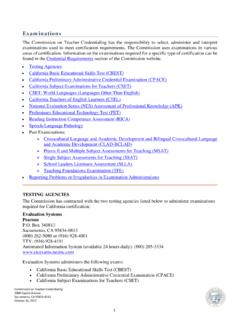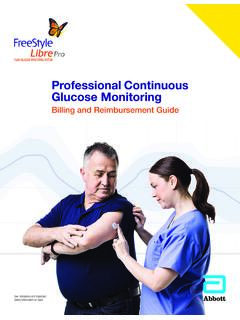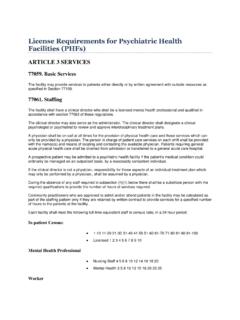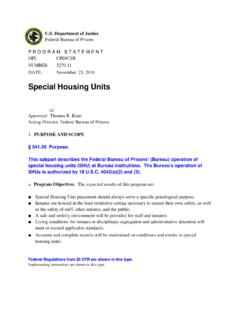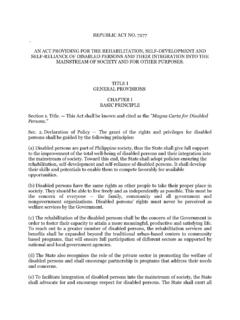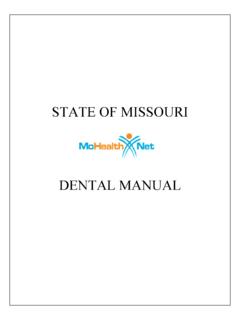Transcription of Summary of Infection Prevention Practices in Dental Settings
1 Summary of Infection Prevention Practices in Dental Settings Basic Expectations for Safe Care iiNote to ReadersThis document is a Summary guide of basic Infection Prevention recommendations for all Dental health care Settings . These include traditional Settings such as private Dental Practices , Dental clinics, Dental schools and educational programs (including Dental assisting, Dental hygiene, and laboratory) and nontraditional Settings that often use portable Dental equipment such as clinics held in schools for sealant and fluoride placement and in other sites for humanitarian Dental the information included in this document reflects existing evidence-based guidelines produced by the Centers for Disease Control and Prevention (CDC)
2 , it is not intended as a replacement for more extensive guidelines. This Summary guide is based primarily upon elements of Standard Precautions and represents a Summary of basic Infection Prevention expectations for safe care in Dental Settings as recommended in the Guidelines for Infection Control in Dental Health-Care Settings 2003. Readers are urged to use the Infection Prevention Checklist for Dental Settings (Appendix A), a companion to the Summary ; and to consult the full guidelines for additional background, rationale, and scientific evidence behind each CitationCenters for Disease Control and Prevention .
3 Summary of Infection Prevention Practices in Dental Settings : Basic Expectations for Safe Care. Atlanta, GA: Centers for Disease Control and Prevention , US Dept of Health and Human Services; October 2016. Adapted from: Guide to Infection Prevention for Outpatient Settings : Minimum Expectations for Safe Care 1 ContentsSuggested Citation ..iiIntroduction ..2 Objectives ..3 Fundamental Elements Needed to Prevent Transmission of Infectious Agents in Dental Settings ..4 Administrative Measures ..4 Infection Prevention Education and Training.
4 4 Dental Health Care Personnel Safety ..5 Program Evaluation ..6 Standard Precautions ..6 Hand Hygiene ..7 Personal Protective Equipment ..7 Respiratory Hygiene / Cough Etiquette ..8 Sharps Safety ..9 Safe Injection Practices ..10 Sterilization and Disinfection of Patient-Care Items and Infection Prevention and Control ..14 Dental Unit Water Quality ..15 Risk Assessment ..16 Conclusions ..16 Source Documents ..17 Appendix A: Infection Prevention Checklist for Dental Settings : Basic Expectations for Safe Care ..18 Section I: Policies and Practices .
5 19 Section II: Direct Observation of Personnel and Patient-Care Practices ..27 Appendix B: Relevant Recommendations Published by CDC Since 2003 ..36 Appendix C: Selected References and Additional Resources by Topic Area ..382 IntroductionTransmission of infectious agents among patients and Dental health care personnel (DHCP) in Dental Settings is rare. However, from 2003 to 2015, transmissions in Dental Settings , including patient-to-patient transmissions, have been 4 In most cases, investigators failed to link a specific lapse of Infection Prevention and control with a particular transmission.
6 However, reported breakdowns in basic Infection Prevention procedures included unsafe injection Practices , failure to heat sterilize Dental handpieces between patients, and failure to monitor ( , conduct spore testing) ,3 These reports highlight the need for comprehensive training to improve understanding of underlying principles, recommended Practices , their implementation, and the conditions that have to be met for disease transmission. All Dental Settings , regardless of the level of care provided, must make Infection Prevention a priority and should be equipped to observe Standard Precautions and other Infection Prevention recommendations contained in CDC s Guidelines for Infection Control in Dental Health-Care Settings The Summary of Infection Prevention Practices in Dental Settings : Basic Expectations for Safe Care summarizes current Infection Prevention recommendations and includes a checklist (Appendix A) that can be used to evaluate compliance.
7 The information presented here is based primarily upon the recommendations from the 2003 guideline and represents Infection Prevention expectations for safe care in Dental Settings . It is intended for use by anyone needing information about basic Infection Prevention measures in Dental health care Settings , but is not a replacement for the more extensive guidelines. Readers are urged to consult the full guidelines for additional background, rationale, and scientific evidence behind each recommendation. Additional topics and information relevant to Dental Infection Prevention and control published by CDC since 2003 in this document can be found in Appendix B including Infection Prevention program administrative measures.
8 Infection Prevention education and training. Respiratory hygiene and cough etiquette. Updated safe injection Practices . Administrative measures for instrument the purposes of this document, DHCP refers to all paid and unpaid personnel in the Dental health care setting who might be occupationally exposed to infectious materials, including body substances and contaminated supplies, equipment, environmental surfaces, water, or air. This includes Dentists. Dental hygienists. Dental assistants. Dental laboratory technicians (in-office and commercial).
9 Students and trainees. Contractual personnel. Other persons not directly involved in patient care but potentially exposed to infectious agents ( , administrative, clerical, housekeeping, maintenance, or volunteer personnel).5 3 ObjectivesBy highlighting existing CDC recommendations, this Summary guide 1. Provides basic Infection Prevention principles and recommendations for Dental health care Settings . 2. Reaffirms Standard Precautions as the foundation for preventing transmission of infectious agents during patient care in all Dental health care Settings .
10 3. Provides links to full guidelines and source documents that readers can reference for more detailed background and recommendations. For additional references, background information, rationale, and evidence, readers should consult the references and resources listed in Appendix C. Detailed recommendations for Dental health care Settings can be found in the compendium document, Recommendations from the Guidelines for Infection Control in Dental Health-Care Settings 2003. References 1. Redd JT, Baumbach J, Kohn W, et al. Patient-to-patient transmission of hepatitis B virus associated with oral surgery.










